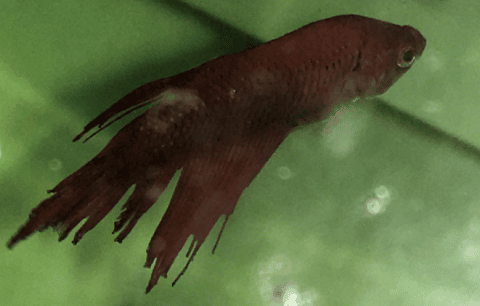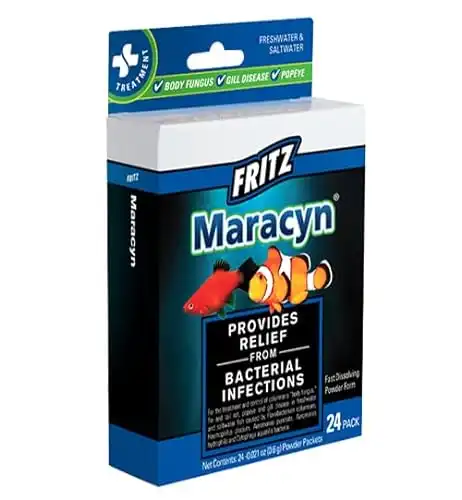Thank you for visiting! By the way… any links on this page that lead to products on Amazon and other stores/partners are affiliate links Aquarium Store Depot earns a commission if you make a purchase.
Owning a betta fish comes with the responsibility of knowing how to care for them and recognizing signs of health issues. These popular aquarium animals have long, flowing fins that give an eye catching look. However, with these fancy fins, you may come across problems like fin rot or loss which need special attention from their betta fish owner so they can stay healthy and happy. Understanding the difference between these two conditions is important when it comes to managing both types of fin complications. I’ll guide you through the details of both today.
Key Takeaways
- Betta fin rot symptoms include darkened or bloodied fin tips, irregular edges and white spots on the fins.
- Identify causes of fin loss in betta fish such as environmental factors, aggressive tank mates and rough handling.
- Fin rot is a bacterial infection, fin loss is due to an injury typically. Both can be recovered from, but a serious injury and result in permanent fin loss.
- Prevent future issues with regular water changes, monitoring temperature & pH levels, creating a natural environment for your fish, and keeping compatible tankmates.
Betta Fin Rot Vs Fin Loss – What’s The Difference

Betta fish can suffer from a condition called fin rot, which is caused by either bacterial or fungal infection. Symptoms should be identified as soon as possible to ensure the betta’s recovery. If left untreated, it could lead to deadly complications. Treating and curing this illness in time is key for its successful management. Fin loss occurs due to injury.
Symptoms
When it comes to fin rot, monitoring your betta fish is important as the symptoms may be hard to spot at first. Signs of this condition can include dark or bloody fins, unusual edges on their fins, lethargy, and white spots appearing on the tips and frayed/ragged edges. As time goes by, these issues worsen with shredded flaps along the exterior as well as possible development of sores that look bloodied up while also noticing a marked decrease in length from when they were healthy before.
The symptoms will often go in stages:
- Stage 1 – Discoloration on edges of fins
- Stage 2 – Ragged fin edges
- Stage 3 – Missing fins or tails
If your fish reaches stage 3, there is a high probability of loss of life. Other symptoms include sluggish behavior and lack of appetite.
Causes
Properly managing water temperature and routinely monitoring tank water parameters are key steps to prevent fin rot from developing in betta fish. These factors, such as elevated ammonia levels or pH fluctuations, can be highly toxic and induce stress which makes the fish more prone to this infection. Poor quality of water is also one of the main causes. When these conditions deteriorate, it increases their susceptibility even further.
Identifying Fin Loss
Betta fish may be subject to physical injury resulting in fin loss due to sharp tank decorations and aggressive tank mates, as well as rough handling. For more serious complications to be prevented, the symptoms of such an issue should be ascertained and its causes identified since it is distinct from fin rot.
Symptoms
It is vital to keep an eye out for any red flags of trouble in your betta fish, especially if their fin loss shows up suddenly. Fin loss is injury related and could become infected. Look around for environment factors that causing the problem.
Causes
In order to stop fin loss in betta fish, it is essential to identify and address the underlying causes. Some of these are sharp tank decorations, aggressive tank mates that exhibit bullying behavior such as chasing or attacking them, and careless handling of the fish itself which can result in physical damage or stress induced fin loss.
The betta fish itself could also be the cause. Some betta fish when bored or stress will bit their own fins and this may cause fin loss or fin rot. The other factor is too much interaction with their reflection, which ends up getting them injured when they try to fight themselves.
Prevention
To decrease the chance of betta fish fin loss, careful monitoring and well chosen tank decorations are key. For decor, look for items that are smooth and if you get fake plants, purchase the silk kind as they will not get caught on your Betta’s fins. Gravel should be smooth, with fine gravel or sand being the most preferable.
Silk plants that are designed to be gentle on fish with fancy fins like Bettas and Fancy Goldfish
Fin loss can be more concerning initially than fin rot because if the injury is severe, the fin may not grow back fully or can get infected. Treat a fin loss injury as stage 3 symptom like you would with fin loss. While they can go back on their own, infection could sink it and monitoring should occur. The good thing with fin loss vs fin rot is that oftentimes times, the fish will still actively eat with the injury.
Treating Rot
Assessing the seriousness of fin rot is essential when determining how best to treat it, as this will ultimately affect your betta’s chances at a full recovery. To address the infection accordingly, different approaches may be necessary depending on its severity.
The first thing to look at are your water parameters. Fin rot is usually caused by poor parameters. Take our your test kit and look for 0 ammonia, 0 nitrites, and under 40 PPM nitrate. You may need to do water changes, feed less, or reduce livestock to get levels where they need to be. Live plants are a great long-term fix but address the immediate issue first before getting into plants.
Mild Cases
When it comes to treating mild fin rot in betta fish, water quality must be improved and monitored. Cleaning the tank is also essential. Regularly performing water changes should be done daily or every other day so as to keep clean waters which can help both remove any toxins that may contribute to fins deteriorating, while promoting healing at the same time.
Also, look at your water flow. If your flow is too strong for your betta this could cause fin rot to occur. Look for sharp decor that may cause injuries. Lastly, check your temperature and see if it is correct. 78 to 80 degrees F is best for them.
If improvements are seen with this disease, then there will no longer be black edges on their fins. A whitish/clear membrane along its edge could form. Similarly, if white areas around those frayed ends have faded away or disappeared all together, these signs point toward recovery from a mild case of fin rot taking place over two up to six weeks duration for full restoration back into healthfulness again!
Severe Cases
In the event of a serious betta fin rot occurrence, it is essential to keep track of water quality and separate the fish in order for medication to be administered appropriately. The first step is to clean out your fish tank to get your nutrient levels in check, as many medications you will use will recommend that you not do water changes during treatment.
Consulting with veterinary or other hobbyist experts before using any antibiotics (i.e., erythromycin) should also be done when treating severe fin rot situations. Treatment should be effective quickly as a fish with fin rot can be afflicted with a secondary infection (due to a weakened immune system) that will often take the fish’s life. A broad spectrum antibiotic is my recommendation when you need to get serious. Erythromycin is a good solution for rot and should be done in a hospital tank. With a hospital tank, you can double up with a product like Ich-X to protect against parasitic infections. Do not use these medications in a planted tank or with inverts as it will damage or kill them.
A broad spectrum antibiotic that works well against fin rot. Safe to use on most fish.
Make sure you remove any chemical filtration when treating your tank, as they will absorb it. Medication will need to stay in your tank for at least a week without a water change so the antibiotics can do its job. Antibiotics have a tendency to reduce oxygen levels so consider adding an air stone or sponge filter to increase your levels.
Addressing Fin Loss
To successfully treat fin loss in betta fish, a clean and healthy environment is essential. This will aid the healing process as well as reduce any risk of infection.
Treatment
In order to deal with fin loss, a number of steps can be taken. Firstly, it is important that the tank holds clean water as this will aid in betta fish recovery from their fin loss. It’s also essential to use slime coat booster so healthy fins regrowth can occur for your betta fish and ensure any sharp objects or aggressive aquatic life are removed that may cause injury when combatted with weakened fins due to lost ones already present on the creature itself.
Stress coat products along with aquarium salt should also be considered treatments for improving an afflicted fish’s condition while at the same time remembering safety must come first by covering filter intakes with sponges, which could potentially harm their vulnerable fins even more than before initiated help was given forthwith afterwards.
Recovery
The regrowth of betta fish fins post fin loss can take anywhere from a few weeks to months, depending on the seriousness of the injury. Signs pointing towards successful recuperation may consist of renewed fins, healthy edges being restored, and with color vibrancy appearing again. Also, increased energy levels and activity plus no black streaks or discoloration seen on the betta fish’s fins would be good indications, too.
It’s also normal for your Betta’s regenerated fins to be a different color than they originally were as they grow back.
Preventing Future Issues
Ensuring a healthy habitat for betta fish is the best way to stop any kind of fin problems, including rot and loss. To create an ideal environment, carefully consider your tank setup as well as water quality in order to make sure that you have a beautiful and strong betta fish living with you for years on end.
Water Quality
It is important to ensure good water quality in order to prevent potential health problems for betta fish. To be proactive, performing a 25% water change weekly can help maintain the health of your aquatic companion. It’s also essential to keep an eye on and adjust any necessary parameters such as temperature (in between 78-80°F or 25-26°C), pH level, ammonia, nitrite levels, and nitrate concentrations. All ideally towards neutral conditions around 7pH.
Tank Setup
When designing a fish tank for betta fish, it’s important to select appropriate tankmates that are non-aggressive and provide plenty of smooth decorations which can minimize the risk of injury or stress. Live plants are optimal in a betta fish aquarium as they help boost water quality while giving them extra nutrients with natural decor such as driftwood, moss balls, and leaves designed specifically for these species. It is best to avoid aggressive inhabitants like angelfish, barbs and fin nipping tetra species since these fish can harm your Betta.
Choose Shoter Finned Varieties
Bettas with shorter fins are less prone to rot or fin loss. They can swim stronger, tolerate strong water flows, and are injured less by decor. If you want to lessen your chances naturally, consider purchasing a Plakat betta variety, as they tend to be more hardy, active, and less prone to injury or infection.
Frequently Asked Questions
What is the difference between fin rot and torn fin?
Fin rot, caused by bacterial damage, is different from torn fins or fin loss which occur due to physical trauma. Torn fins are often localized and will not exhibit connecting spots like those associated with fin rot. Both conditions can be treated if the proper approach is taken. Fin loss injuries can also result in an infection of parameters are not ideal or if the injury is severe.
What does the beginning of fin rot look like?
Early signs of fin rot include fins that take on a milky, discolored appearance. Fraying can occur at the tail or other parts of the fins as pieces start to come off in an uneven manner. Inflammation around the base may be present with noticeable white, black and brown changes along its edges. All these together could indicate this health condition among fish species.
Why is my betta fish’s fins falling off?
Betta fish may be vulnerable to fin rot, a bacterial or fungal infection caused by poor water quality and tank size. Mishandling and aggressive behavior from other fish can contribute to the onset of this affliction as well as injuries inflicted upon them. Poor care complicates matters for these unfortunate creatures too – thus good maintenance is essential for minimizing any risks in relation to both their health and survival.
Do betta fins grow back after fin rot?
Bettas’ delicate fins can regrow in optimal conditions. Thus, it is essential to keep up with regular water changes and ensure the quality of aquariums’ waters for proper repair of damaged appendages.
Can betta fish recover from fin rot and fin loss?
Betta fish can heal from rot and fin loss provided suitable treatment is provided. With care, these majestic creatures have the ability to recover from fin rot and resultant fin damage.
Closing Thoughts
With all the fancy finned varieties of Bettas available now and with new breeds being introduced, running into fin rot in Bettas is becoming more common. If you set up the right environment, keep healthy parameters, and choose the right tankmates, you should be able to prevent rot or loss from happening.
What’s been your experience with either condition? Let us know in the comments and let’s start a conversation. It’s always great to hear from other betta pet owners.
- About the Author
- Latest Posts
I’m thrilled that you found Aquarium Store Depot! Here you’ll find information on fish, aquariums, and all things aquatics related. I’m a hobbyist (being doing this since I was 11) and here to help other hobbyists thrive with their aquariums! I adhere to a high quality Editorial Process and Review products with real life field usage and practical analysis.







